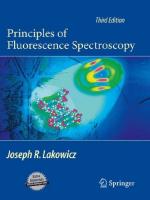|
This section contains 1,193 words (approx. 4 pages at 300 words per page) |

|
Fluorescence and phosphorescence are both luminescence phenomena that occur due to the de-excitation of electrons. When a source of energy such as thermal or radiant energies is applied to a fluorescent material, high energy particles or photons collide with the electrons in the material, causing them to become excited and jump to a higher energy level. The electrons in the excited state have the same spin as they did in the ground state. The electrons in this excited state are not stable and almost spontaneously become de-excited and move back down to the lower energy levels, releasing energy in the form of light. When the source of energy is removed, the light emission ceases. A fluorescent state can exist for only 10-5 to 10-8 seconds. One familiar example of this phenomenon is a "black light" poster. "Black light" posters are painted with fluorescent ink...
|
This section contains 1,193 words (approx. 4 pages at 300 words per page) |

|


